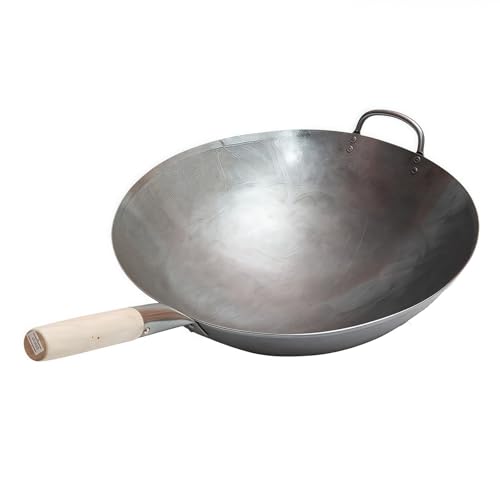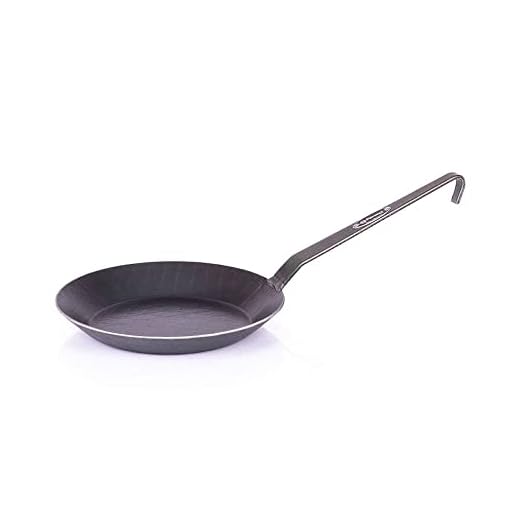



A wrought iron skillet is a versatile and durable piece of cookware that can last for generations when properly cared for. Seasoning is the process of treating the surface of the skillet to prevent rust, improve its non-stick properties, and enhance its overall performance. While it may seem like a daunting task, seasoning a wrought iron skillet is a simple process that anyone can do at home.
First, start by thoroughly cleaning the skillet. Use hot water and a brush to remove any food residue or rust. Avoid using soap, as it can strip away the natural oils in the iron. Once the skillet is clean, dry it completely with a towel to ensure that no moisture is left behind.
Next, apply a thin layer of oil to the skillet. Traditional choices include vegetable oil, canola oil, or flaxseed oil. Pour a small amount of oil into the skillet and use a paper towel to evenly coat the entire cooking surface. Make sure to also oil the handle and any other exposed areas. Once the skillet is coated, use a new clean paper towel to wipe off any excess oil.
Now, it’s time to bake the skillet. Preheat your oven to a high temperature, usually around 400°F (200°C). Place the skillet upside down on the oven’s middle rack, with a piece of aluminum foil or a baking sheet on the bottom rack to catch any drips. Let the skillet bake for about an hour. This process allows the oil to polymerize, creating a hard and smooth surface.
Once the hour is up, turn off the oven and let the skillet cool completely before removing it. Be careful, as it will be hot. Your wrought iron skillet is now seasoned and ready for use! To maintain its seasoning, avoid using soap or abrasive materials when cleaning the skillet. Instead, rinse it with hot water and scrub gently with a brush. Dry it thoroughly and apply a thin layer of oil after each use to keep the skillet well seasoned.
In conclusion, seasoning a wrought iron skillet is a simple and important step in its care and maintenance. By following these steps, you can ensure that your skillet is well-seasoned, rust-free, and provides excellent cooking results every time.
Why Seasoning a Wrought Iron Skillet is Essential
A wrought iron skillet is a versatile and durable cooking tool that can last for generations if properly cared for. One crucial step in caring for your skillet is the process of seasoning, which involves conditioning the surface to create a non-stick layer. Seasoning is essential for several reasons:
1. Prevents Rust
Wrought iron is prone to rust, and seasoning provides a protective barrier against moisture. When properly seasoned, the skillet’s surface becomes resistant to rusting, allowing it to be used and stored without worry. Regular seasoning maintenance can ensure that your skillet remains rust-free.
2. Enhances Non-Stick Properties
Seasoning gives the skillet a natural non-stick surface. When heated, the oil used during seasoning forms a polymerized layer that bonds to the iron, creating a smooth and slick surface. This prevents food from sticking and makes cooking and cleaning easier.
| Benefits of Seasoning: | Drawbacks of Not Seasoning: |
|---|---|
| Improved non-stick properties | Food sticking to the surface |
| Protection against rust | Rust and corrosion |
| Enhanced flavor and cooking performance | Uneven heat distribution |
3. Enhances Flavor and Cooking Performance
Seasoning also improves the flavor and cooking performance of your food. As the seasoning layer continues to develop over time, it adds a unique flavor to your dishes. Additionally, a properly seasoned skillet distributes heat evenly, allowing for consistent and superior cooking results.
In conclusion, seasoning a wrought iron skillet is essential for preventing rust, enhancing non-stick properties, and improving flavor and cooking performance. By regularly seasoning your skillet, you can ensure its longevity and enjoy the many benefits it provides.
Benefits of Properly Seasoned Skillet
Properly seasoning your wrought iron skillet can offer a variety of benefits, making it an essential cooking tool in your kitchen.
Enhanced Non-Stick Surface: A properly seasoned skillet develops a natural non-stick surface, which allows you to cook with less oil or fat. This makes it ideal for healthier cooking options.
Improved Heat Distribution: Seasoning creates a smooth and even layer on the skillet’s surface, ensuring better heat distribution. This means your food will cook more evenly, preventing hotspots and ensuring consistent results every time.
Long-Lasting Durability: Seasoning helps protect the skillet from rust and corrosion, extending its lifespan. It acts as a barrier between the metal and the food, preventing it from directly coming into contact with the iron.
Flavor Enhancement: A well-seasoned skillet can impart a unique and delicious flavor to your food. The seasoning process creates a polymerized layer that adds depth and richness to your dishes.
Easy Cleaning: With a properly seasoned skillet, you’ll find cleaning to be a breeze. Food is less likely to stick to the surface, making it easier to remove residue. Simply wipe it clean with a soft cloth or rinse with hot water.
Versatility: A seasoned skillet can be used for a wide range of cooking methods, including frying, sautéing, baking, and even grilling. Its versatility makes it a go-to cookware for various recipes.
By taking the time to season your wrought iron skillet properly, you’ll unlock a world of fantastic benefits that will enhance your cooking experience and make your meals even more delicious.
Step-by-Step Guide to Season Your Wrought Iron Skillet
Seasoning your cast iron skillet is essential to create a non-stick surface and prevent rust. Follow these simple steps to properly season your wrought iron skillet:
1. Clean the Skillet
Start by cleaning your skillet with warm water and a stiff brush. Avoid using soap as it can remove the seasoning. Scrub off any food particles or rust until the surface is smooth and clean.
2. Dry the Skillet
Thoroughly dry the skillet with a clean towel. Any moisture left on the skillet can cause rust, so make sure it is completely dry before proceeding.
3. Apply a Thin Layer of Oil
Using a paper towel, apply a thin layer of oil to the skillet. This could be vegetable oil, canola oil, or even flaxseed oil. Make sure to cover the entire surface, including the handle and sides.
4. Bake the Skillet
Preheat your oven to 350 degrees Fahrenheit (175 degrees Celsius). Place the oiled skillet upside down on the oven’s center rack. This allows any excess oil to drip off. Place a baking sheet or aluminum foil on the bottom rack to catch any drips.
Bake the skillet for one hour. This process creates a polymerized layer that forms a protective coating on the skillet.
5. Cool and Repeat
After one hour, turn off the oven and let the skillet cool completely inside. Once cooled, check the seasoning. If the skillet appears dull, repeat steps 3 and 4 to add another layer of seasoning.
Repeat the seasoning process several times until the skillet develops a smooth, black patina. This will enhance its non-stick properties and make it more durable over time.
6. Maintain Your Seasoning
To maintain the seasoning of your wrought iron skillet, avoid using soap when cleaning. Instead, rinse it with hot water and scrub gently with a brush. Dry the skillet thoroughly, and apply a thin layer of oil after each use to prevent rust.
Following these steps will ensure that your wrought iron skillet remains in excellent condition and provides you with years of cooking pleasure!
Common Mistakes to Avoid When Seasoning
Seasoning a wrought iron skillet requires careful attention and a few key steps. However, there are also some common mistakes that people make when trying to season their skillet. Here are a few common mistakes to avoid:
1. Overheating: One of the most common mistakes is overheating the skillet. Excessive heat can cause the oil to burn and form a sticky residue on the surface. To avoid this, it’s essential to follow the recommended temperature guidelines and maintain a controlled heat while seasoning.
2. Using the wrong oil: Choosing the right oil is crucial for achieving a proper seasoning. Avoid oils with low smoke points, such as olive oil, as they can break down at high temperatures. Instead, opt for oils like vegetable oil, canola oil, or flaxseed oil, which have higher smoke points and better stability for seasoning.
3. Applying too much oil: While a thin layer of oil is necessary to season the skillet, applying too much oil can lead to a sticky and uneven surface. It’s important to use a cloth or paper towel to evenly distribute a thin layer of oil on the skillet’s surface, ensuring that no excess oil pools in the corners or edges.
4. Skipping the cleaning step: Properly cleaning the skillet before seasoning is crucial. Some people make the mistake of skipping the cleaning step, thinking that the seasoning will cover any dirt or residue. However, this can result in inconsistent seasoning, and the dirt or residue can affect the final quality of the seasoned surface.
5. Rushing the process: Seasoning a skillet takes time and patience. Some people make the mistake of rushing the process or not allowing enough time for each layer of seasoning to fully bond with the surface. It’s recommended to apply multiple layers of seasoning, allowing each layer to dry and polymerize before adding the next one.
By avoiding these common mistakes, you can ensure that your wrought iron skillet is properly seasoned and ready for all your cooking needs.
FAQ
What is a wrought iron skillet?
A wrought iron skillet is a type of cookware made from cast iron that has been hand forged, giving it a unique and rustic appearance.
Why should I season a wrought iron skillet?
Seasoning a wrought iron skillet helps to create a non-stick surface, prevent rust, and improve the flavor of cooked food.
How do I season a new wrought iron skillet?
To season a new wrought iron skillet, wash it with hot, soapy water and then dry it completely. Apply a thin layer of oil to the skillet, making sure to cover the entire surface. Place the skillet in the oven and bake it at a high temperature for at least one hour. Repeat this process several times to build up a good seasoning.
Can I season a rusty wrought iron skillet?
Yes, you can season a rusty wrought iron skillet. First, scrub off the rust using steel wool or a wire brush. Then, follow the same seasoning process as for a new skillet.
How often should I season my wrought iron skillet?
You should season your wrought iron skillet on a regular basis, especially after each use. This will help to maintain the seasoning and prevent the skillet from rusting.











